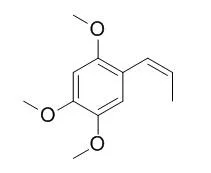| Description: |
beta-Asarone has neuroprotection, anti-tumor, anthelmintic, anti-inflammary, and anticoagulant effects, it can afford a beneficial inhibition on both mRNA and protein expression of Bad, Bax, and cleavage of caspases 9 in rat hippocampus following intrahippocampal injections of Abeta (1-42).beta-Asarone prevents autophagy and synaptic loss by reducing ROCK expression in SAMP8 mice. beta Asarone can cause liver and cardiac damages, it also has reproductive toxicity.
|
| Targets: |
NF-kB | NO | NOS | COX | JNK | Beta Amyloid | mTOR | Akt | p53 | p21 | ROCK |
| In vitro: |
| Nat Prod Commun. 2009 Feb;4(2):275-8. | | Compositional variations and anthelmentic activity of essential oils from rhizomes of different wild populations of Acorus calamus L. and its major component, beta-Asarone.[Pubmed: 19370938] | Hydro-distilled essential oils from Acorus calamus rhizomes collected from six different geographical zones in the northwest Himalayan region of Uttarakhand have been analyzed by GC and GC/MS.
METHODS AND RESULTS:
All the oils differed in their qualitative and quantitative make up, although beta-Asarone was the major constituent of all of them. The essential oils and the isolated beta-Asarone were screened for anthelmintic activity using contractility of Ascaridia galli. beta-Asarone, in particular, showed potent activity with IC50 values of 75.4 +/- 61.8 ng/mL. | | Food Chem Toxicol. 2014 Oct;72:265-72. | | β-Asarone (cis-2,4,5-trimethoxy-1-allyl phenyl), attenuates pro-inflammatory mediators by inhibiting NF-κB signaling and the JNK pathway in LPS activated BV-2 microglia cells.[Pubmed: 25066769] | Acorus species contains diverse pharmacologically active phytochemicals including α-asarone, beta-Asarone, and eugenol.
METHODS AND RESULTS:
We determined if beta-Asarone isolated from Acorus gramineus (AG) Solander would be efficacious in protecting BV-2 microglia cells from lipopolysaccharide (LPS)-induced stress signaling. BV-2 microglial cells were pretreated with an AG ethanol extract (1, 10, and 100 μg/mL) or beta-Asarone (10, 50, and 100 μM) prior to exposure to LPS (100 ng/mL). AG and beta-Asarone inhibited LPS-induced production of nitric oxide in a dose-dependent manner. The mRNA and protein levels of inducible nitric oxide synthase and cyclooxygenase-2 also decreased dose dependently following AG and beta-Asarone treatments. Immunostaining and immunoblot studies revealed that beta-Asarone also suppressed nuclear factor (NF)-κB activation by blocking IkB degradation. Further mechanistic studies revealed that beta-Asarone acted through the JNK/MAPK pathway.
CONCLUSIONS:
Taken together, our findings demonstrate that beta-Asarone exhibits anti-inflammatory effects by suppressing the production of pro-inflammatory mediators through NF-κB signaling and the JNK pathways in activated microglial cells and might be developed as a promising candidate to treat various neuroinflammatory diseases. |
|
| In vivo: |
| Phytomedicine. 2013 Apr 15;20(6):512-20. | | β-Asarone induces senescence in colorectal cancer cells by inducing lamin B1 expression.[Pubmed: 23357361 ] | Colorectal cancer is a leading cause of cancer mortality with a complex carcinogenesis that includes reduced cellular senescence. Lamin proteins are decreased in senescing cells, and frequently decreased in malignancies.
METHODS AND RESULTS:
This study identified a new drug candidate for colorectal cancer that appears to target cell senescence via a lamin protein. beta-Asarone (1-propenyl-2,4,5-methoxybenzol) is a compound from the traditional medical herb Acorus calamus Linn. This study tested the in vitro and in vivo effects of beta-Asarone on colorectal cancer cells by testing cell viability using human colorectal cell lines HT29 and SW480 in MTT assays; tumorigenesis using xenografts in nude mice and a mouse model of colorectal cancer; cell senescence using senescence-associated β-galactosidase activity; and expression of cancer and senescence-related proteins, specifically lamins, Oct-1, p53, p21, and p15, by Western blot. beta-Asarone appeared to increase expression of lamin B1, p53, p21, but not lamin A/C. beta-Asarone regulates p15 expression by regulation of Oct-1 binding.
CONCLUSIONS:
Collectively, the results suggested that beta-Asarone inhibits colon cancer formation in vivo and in vitro by inducing senescence. Since beta-Asarone induced lamin B1 expression, a model is proposed in which beta-Asarone inhibits colorectal cancer by inducing senescence through lamin B1. | | Biomed Pharmacother . 2016 Oct;83:153-159. | | Beta-asarone protects against MPTP-induced Parkinson's disease via regulating long non-coding RNA MALAT1 and inhibiting α-synuclein protein expression[Pubmed: 27470562] | | Abstract
Objective: Numerous long non-coding RNAs (lncRNA) have been identified in neurodegenerative disorders including Parkinson's disease (PD). Emerging evidence demonstrates that β-asarone functions as neuroprotective effects in both in vitro and in vivo models. However, the role of β-asarone and its potential mechanism in PD remain not completely clear.
Methods: MPTP-induced PD mouse model and SH-SY5Y cells subjected to MPP+ as its in vitro model were used to evaluate the effects of β-asarone on PD. LncRNA MALAT1 and α-synuclein expression were determined by real-time PCR and western blot methods.
Results: β-Asarone significantly increased the TH+ cells number and decreased the expression levels of MALAT1 and α-synuclein in midbrain tissue of PD mice. RNA pull-down and immunoprecipitation assays confirmed that MALAT1 associated with α-synuclein, leading to the increased stability of α-synuclein and its expression in SH-SY5Y cells. β-asarone elevated the viability of cells exposed to MPP+. Either overexpressed MALAT1 or α-synuclein could canceled the protective effect of β-asarone on cell viability. In PD mice, pcDNA-MALAT1 also decreased the TH+ cells number and increased the α-synuclein expression in PD mice with treatment of β-asarone.
Conclusion: β-Asarone functions as a neuroprotective effect in both in vivo and in vitro models of PD via regulating MALAT1 and α-synuclein expression.
Keywords: Long non-coding RNA; Parkinson’s disease; α-Synuclein; β-Asarone. |
|






 Cell. 2018 Jan 11;172(1-2):249-261.e12. doi: 10.1016/j.cell.2017.12.019.IF=36.216(2019)
Cell. 2018 Jan 11;172(1-2):249-261.e12. doi: 10.1016/j.cell.2017.12.019.IF=36.216(2019) Cell Metab. 2020 Mar 3;31(3):534-548.e5. doi: 10.1016/j.cmet.2020.01.002.IF=22.415(2019)
Cell Metab. 2020 Mar 3;31(3):534-548.e5. doi: 10.1016/j.cmet.2020.01.002.IF=22.415(2019) Mol Cell. 2017 Nov 16;68(4):673-685.e6. doi: 10.1016/j.molcel.2017.10.022.IF=14.548(2019)
Mol Cell. 2017 Nov 16;68(4):673-685.e6. doi: 10.1016/j.molcel.2017.10.022.IF=14.548(2019)